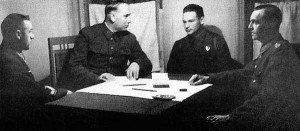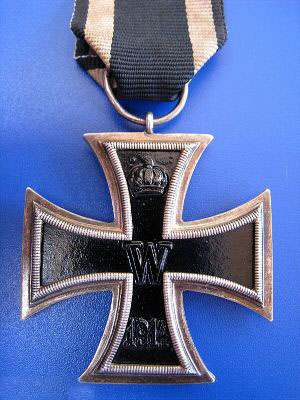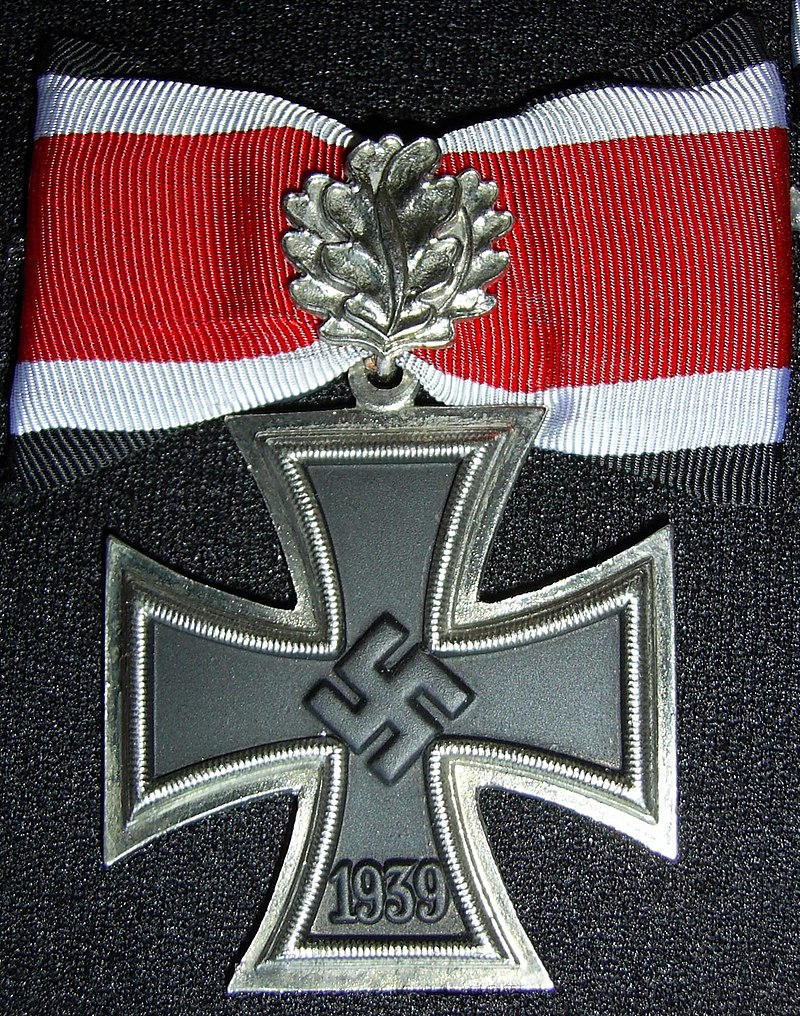Seydlitz-Kurzbach, Walther von, born 22-08-1888 in Hamburg  , into the noble Prussian von Seydlitz family
, into the noble Prussian von Seydlitz family  from Alexander von Seydlitz-Kurzbach and his wife Helene, born, von Guenther as one of their eight children. He was a direct descendant of the famous Prussian General Friedrich Wilhelm Freiherr von Seydlitz.
from Alexander von Seydlitz-Kurzbach and his wife Helene, born, von Guenther as one of their eight children. He was a direct descendant of the famous Prussian General Friedrich Wilhelm Freiherr von Seydlitz.  He had seven siblings and made his final examination in 1908 and joined the Reichswehr as a Fahnenjunker, shoulder emblem,
He had seven siblings and made his final examination in 1908 and joined the Reichswehr as a Fahnenjunker, shoulder emblem, ![]() with a Feldartillerie Regiment in Danzig. After he finished the war school he was promoted to Leutnant in 1910. During World War I he served on both fronts as an officer. In 1916/17 in the West at the Somme river and in 1918 in the East. Promoted to Oberleutnant in 1915 and to Hauptmann in 1917 he received both the Iron Crosses
with a Feldartillerie Regiment in Danzig. After he finished the war school he was promoted to Leutnant in 1910. During World War I he served on both fronts as an officer. In 1916/17 in the West at the Somme river and in 1918 in the East. Promoted to Oberleutnant in 1915 and to Hauptmann in 1917 he received both the Iron Crosses  and the wounded medal in Silver
and the wounded medal in Silver  and in 1918 the Ritterkreuz des Königlichen Hausordens von Hohenzollern
and in 1918 the Ritterkreuz des Königlichen Hausordens von Hohenzollern ![]()
Hauptman Walther Kurt von Seydlitz-Kurzbach married his fiancée Ingeborg Barth (1903–1987) from Untergreißlau near Weißenfels in 1922, daughter of Prof. Dr. Arthur Barth,  who was a celebrity in Dresden. When his wife found out about his machinations, the marriage was divorced in 1944 (allegedly, according to the post-war version, enforced by the OKW). In 1956, after his return, they remarried. The marriage gave birth to four daughters: Mechthild (1925–1959), Dietlind (born 1927), Ingrid (born 1934) and Ute (born 1936).
who was a celebrity in Dresden. When his wife found out about his machinations, the marriage was divorced in 1944 (allegedly, according to the post-war version, enforced by the OKW). In 1956, after his return, they remarried. The marriage gave birth to four daughters: Mechthild (1925–1959), Dietlind (born 1927), Ingrid (born 1934) and Ute (born 1936).
Von Seydlitz was allowed in the new Reichswehr as an officer with the Border Protection Feldartillerie Brigade on the East border in Schwerin. From 1929 he was as Adjutant with the Chief of the Army Weapon Department in the Reichswehrministry and promoted to Major in 1930. In 1933 he was transferred as commander of a Cavalry Artillerie Regiment in Verden, where his family lived. Promoted to Oberstleutnant in 1934 and to Oberst in 1936 with the command of the 22nd Artillerie Regiment with the 22nd Infantry Division  , under command of then Generalleutnant Adolf Strauss.
, under command of then Generalleutnant Adolf Strauss.  The last remains of this division surrendered to the British near Klagenfurt on 11-05-1945. He lost his command of the 22nd and was assigned as commander of the Artilleriekommand 102, Arko102 in Potsdam and from 01-12-1939 promoted to Generalmajor. In March 1940 he was relieved from this command and appointed as commander of the 12th Infantry Division
The last remains of this division surrendered to the British near Klagenfurt on 11-05-1945. He lost his command of the 22nd and was assigned as commander of the Artilleriekommand 102, Arko102 in Potsdam and from 01-12-1939 promoted to Generalmajor. In March 1940 he was relieved from this command and appointed as commander of the 12th Infantry Division  , where he succeeded General Ludwig von der Leyen
, where he succeeded General Ludwig von der Leyen
 who died age 81 on 03-02-1967 in Malente. Von Seydlitz was commander of this division during the invasion in the West in May 1940 and awarded with the clasps of the his Iron Crosses. After the Western campaign his division remained in France as occupation force and he was awarded with the Knight Cross of the Iron Cross. His division took part in the invasion of Russia, Operation Barbarossa, as an unit in the 16th Army under command of Generalfeldmarschall Ernst Busch.
who died age 81 on 03-02-1967 in Malente. Von Seydlitz was commander of this division during the invasion in the West in May 1940 and awarded with the clasps of the his Iron Crosses. After the Western campaign his division remained in France as occupation force and he was awarded with the Knight Cross of the Iron Cross. His division took part in the invasion of Russia, Operation Barbarossa, as an unit in the 16th Army under command of Generalfeldmarschall Ernst Busch.  Promoted to Generalleutnant on 01-12-1941 and awarded with the Oak Leaves.
Promoted to Generalleutnant on 01-12-1941 and awarded with the Oak Leaves.![]() When the division was encircled in the Demyansk Pocket, von Seydlitz was responsible for breaking the Soviet cordon and enabling German units to escape from encirclement, for this action he was promoted to General of the Artillery and appointed commander of the LI Corps. He was recipient of the Knight’s Cross of the Iron Cross with Oak Leaves.
When the division was encircled in the Demyansk Pocket, von Seydlitz was responsible for breaking the Soviet cordon and enabling German units to escape from encirclement, for this action he was promoted to General of the Artillery and appointed commander of the LI Corps. He was recipient of the Knight’s Cross of the Iron Cross with Oak Leaves.  The corps was subordinated to the Sixth Army
The corps was subordinated to the Sixth Army  during the Battle of Stalingrad, Friedrich Paulus
during the Battle of Stalingrad, Friedrich Paulus  When the entire Army was trapped in the city in the course of the Soviet Operation Uranus, von Seydlitz was one of the Generals who argued most forcefully in favor of a breakout, in contravention of Hitler’s orders.
When the entire Army was trapped in the city in the course of the Soviet Operation Uranus, von Seydlitz was one of the Generals who argued most forcefully in favor of a breakout, in contravention of Hitler’s orders.  On the surrender of the remaining forces in Stalingrad, Seydlitz was taken into Soviet custody, where he was interrogated by Captain Nikolay Dyatlenko, he died in 1996, age 82.
On the surrender of the remaining forces in Stalingrad, Seydlitz was taken into Soviet custody, where he was interrogated by Captain Nikolay Dyatlenko, he died in 1996, age 82. The interrogation of von Paulus at Don Front HQ. Left to right: General Konstantin Rokossovski,
The interrogation of von Paulus at Don Front HQ. Left to right: General Konstantin Rokossovski, Marshal Voronov, Dyatlenko and Field Marshal von Paulus. As a POW he became the leader of the anti-Nazi organization, the League of German Officers, Bund Deutscher Offiziere and a prominent member of the National Committee Free Germany, Nationalkomitee Freies Deutschland
Marshal Voronov, Dyatlenko and Field Marshal von Paulus. As a POW he became the leader of the anti-Nazi organization, the League of German Officers, Bund Deutscher Offiziere and a prominent member of the National Committee Free Germany, Nationalkomitee Freies Deutschland  . An very fanatic anti Free Committee General was Generaloberst Walter Heitz
. An very fanatic anti Free Committee General was Generaloberst Walter Heitz 
 He was condemned by many of his fellow Generals for his anti-Nazi activities and was sentenced to death in absentia. His idea of creating an anti-Nazi force of some 40.000 German POW’s to be airlifted into Germany was not considered credible, while in Germany his family was taken into Sippenhaft, prison, detention for the crimes of a family member. Von Seydlitz was ultimately exploited by both Soviet and German propaganda: he was used by the former in broadcasts and literature to encourage German soldiers to surrender, while the latter cultivated the idea of “Seydlitz troops” , German: Seydlitz truppen.
He was condemned by many of his fellow Generals for his anti-Nazi activities and was sentenced to death in absentia. His idea of creating an anti-Nazi force of some 40.000 German POW’s to be airlifted into Germany was not considered credible, while in Germany his family was taken into Sippenhaft, prison, detention for the crimes of a family member. Von Seydlitz was ultimately exploited by both Soviet and German propaganda: he was used by the former in broadcasts and literature to encourage German soldiers to surrender, while the latter cultivated the idea of “Seydlitz troops” , German: Seydlitz truppen.

%2C%20Oberst%20Franz%20Scheidies%20(43_%20EL)%2C%20Oberleutnant%20Ernst-Georg%20Buchterkirch%20(44_%20EL)_0.jpg)

Death and burial ground of Seydlitz-Kurzbach, Walther Kurt von.


 Walther Kurt von Seydlitz-Kurzbach died on 28-04-1976, age 68, completely bitter and disillusioned, in Bremen. He is buried with his wife Ingeborg, born Barth, who died age 83, 22-04-1987, on the cemetery Riensberg in Bremen, between several WWII colleagues as, Generalarzt, Wehrmacht Generalarzt 10st Heereskorps, Dr. Rudolf Attig,
Walther Kurt von Seydlitz-Kurzbach died on 28-04-1976, age 68, completely bitter and disillusioned, in Bremen. He is buried with his wife Ingeborg, born Barth, who died age 83, 22-04-1987, on the cemetery Riensberg in Bremen, between several WWII colleagues as, Generalarzt, Wehrmacht Generalarzt 10st Heereskorps, Dr. Rudolf Attig,  The Bundeswehr refused the military honors. On 23-04-1996 his conviction as a war criminal in Russia was overturned by the Moscow Public Prosecutor’s Office.
The Bundeswehr refused the military honors. On 23-04-1996 his conviction as a war criminal in Russia was overturned by the Moscow Public Prosecutor’s Office.

Message(s), tips or interesting graves for the webmaster: robhopmans@outlook.com






















Lodieu
All my congratulations for your web-site.
Lynn mcculloch
Enjoy your gravestone articles very very much